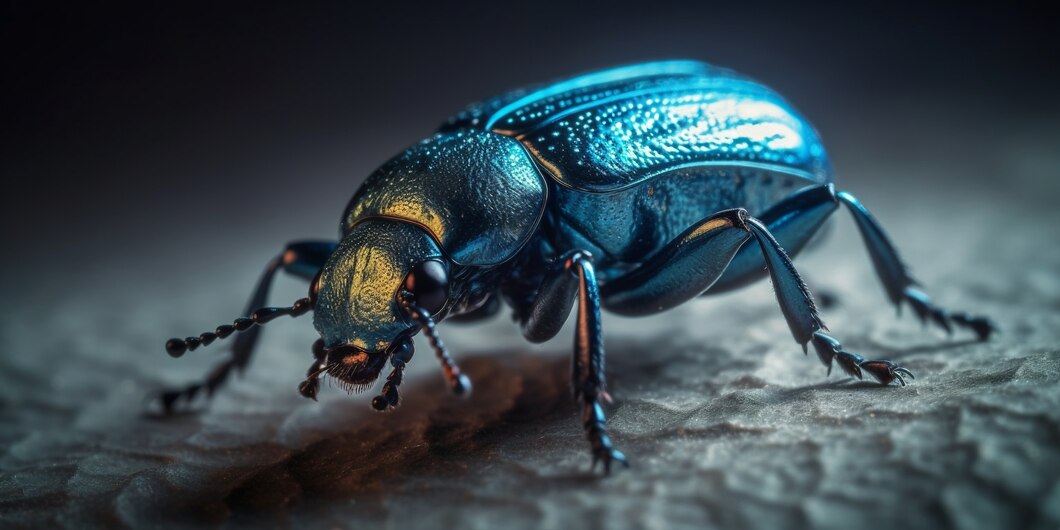The Blue Death Feigning Beetle, scientifically known as Asbolus verrucosus, is a unique species of darkling beetle native to the southwestern United States and northwestern Mexico. This remarkable insect has captured the attention of both researchers and pet enthusiasts alike due to its distinctive appearance, fascinating behavior, and remarkable adaptations to its harsh desert environment.
Appearance and Adaptations
One of the most striking features of the Blue Death Feigning Beetle is its powdery blue coloration. This unique hue is not the beetle’s natural color, but rather a result of a waxy coating that covers its body. This coating serves a vital purpose in the beetle’s desert habitat, protecting it from the harmful effects of intense sunlight and preventing moisture loss.The species name “verrucosus” refers to the characteristic bumps, or warts, on the beetle’s elytra (hardened forewings). These bumps are thought to help the beetle blend in with its surroundings and avoid detection by predators.Despite its small size, ranging from 18-21 mm in length, the Blue Death Feigning Beetle is highly adapted to its harsh environment. Its crepuscular (active at dawn and dusk) lifestyle and omnivorous diet, which includes dead insects, fruits, lichen, and other plant matter, allow it to thrive in the desert.
Behavior and Reproduction
The Blue Death Feigning Beetle is perhaps best known for its unique defense mechanism: when threatened, it will feign death by remaining motionless and retracting its legs and antennae. This behavior, which gives the beetle its common name, is thought to confuse and deter predators.Breeding the BlueDeath Feigning Beetle in captivity has proven to be a challenge for researchers. The majority of captive beetles are wild-caught, and maintaining the proper humidity and temperature required for larvae to pupate has been a significant obstacle. However, in 2018, researchers at the Cincinnati Zoo were able to successfully rear their first adult beetle after beginning breeding efforts in 2014.
Conservation and Pet Trade
The BlueDeath Feigning Beetle is not currently listed as a threatened species by the IUCN, and its numbers in the wild appear to be stable. However, like many desert species, it may face potential threats from habitat loss and climate change.Despite these challenges, the BlueDeath Feigning Beetle has become increasingly popular in the pet trade. Its ease of care, hardiness, and longevity (up to 8 years in captivity) make it an attractive choice for insect enthusiasts. However, it is important to note that the majority of captive beetles are wild-caught, and responsible pet ownership is essential to ensure the species’ continued survival in the wild.
Conclusion
The Blue Death Feigning Beetle is a fascinating example of the incredible diversity and adaptability of life in the desert. Its unique appearance, behavior, and life history make it a captivating subject for researchers and nature enthusiasts alike. As we continue to learn more about this enigmatic species, we can appreciate the wonders of the natural world and work to protect the delicate balance of desert ecosystems.
FAQs
What is the Blue Death Feigning Beetle?
The BlueDeath Feigning Beetle, scientifically known as Asbolus verrucosus, is a unique species of darkling beetle native to the southwestern United States and northwestern Mexico. It is known for its distinctive blue coloration, which is caused by a waxy coating on its body, and its fascinating behavior of feigning death when threatened.
Why is the Blue Death Feigning Beetle blue?
The blue coloration of the BlueDeath Feigning Beetle is not its natural color, but rather a result of a waxy coating that covers its body. This coating serves to protect the beetle from the harmful effects of intense sunlight and prevent moisture loss in its desert habitat.
How does the Blue Death Feigning Beetle defend itself?
When threatened, the BlueDeath Feigning Beetle will feign death by remaining motionless and retracting its legs and antennae. This behavior, which gives the beetle its common name, is thought to confuse and deter predators.
Can the Blue Death Feigning Beetle be kept as a pet?
Yes, the BlueDeath Feigning Beetle has become increasingly popular in the pet trade due to its ease of care, hardiness, and longevity (up to 8 years in captivity). However, it is important to note that the majority of captive beetles are wild-caught, and responsible pet ownership is essential to ensure the species’ continued survival in the wild.
- Is the Blue Death Feigning Beetle endangered?
The BlueDeath Feigning Beetle is not currently listed as a threatened species by the IUCN, and its numbers in the wild appear to be stable. However, like many desert species, it may face potential threats from habitat loss and climate change. Responsible pet ownership and conservation efforts are important to ensure the species’ continued survival.










